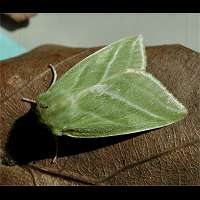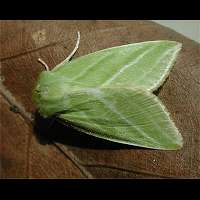Green Silver-lines Pseudoips prasinana
It is hardly possible to mistake the Green Silver-lines for any other species. It is bright light green with three silvery white lines running over the wing. Sometimes white bands are visible in the middle of the front wing and near the edge of it. The head and the thorax are green as well. The antennae are pink or orange. Both palps and front legs are pink. Other legs are pinkish or white. Males and females differ in one respect: the colour of the hind wings: yellowish white in males and snowwhite in females. The only species looking like it is the Scarce Silver-lines. That species however is larger, darker, the green is not clouded by white and it has two very straight silvery lines only. The Green Silver-lines reaches a wingspan of 32 to 40mm.
The eggs are laid one by one in summer. They are very flat and white with a red dot when just laid. After that they quickly become more red and then do look like small plant galls indeed. The caterpillars are yellowish green when young and darker green reaching maturity. The body is entirely covered in small yellow markings. There are whitish yellow subdorsal lines and just behind the bright all green head is a striking yellow collar. In autumn the caterpillars make strong, boat shaped cocoons, which are attached to leaves, between leaf litter or in crevices in the bark of trees. Pupation and overwintering as a pupa takes place inside this cocoon. The larvae are found on several trees, such as beech, birch and hazel, but oak is the favourite tree indeed. The caterpillars of the Green Silver-lines reach a length of some 34 to 38mm.
The Green Silver-lines usually flies in just one generation from May to mid July. There is however an occasional very small second generation in the south of England and on the continent, on the wing in August and September. The species flies during the night only, but is easily attracted to light. Careful photographers may find this species may be handled before taking pictures. Can be found on dry sandy soils only, which makes it a rather local species all over Europe. Common, widespread, but local all over Britain, except for Scotland, where it is locally common in the south only.
It is hardly possible to mistake the Green Silver-lines for any other species. It is bright light green with three silvery white lines running over the wing. Sometimes white bands are visible in the middle of the front wing and near the edge of it. The head and the thorax are green as well. The antennae are pink or orange. Both palps and front legs are pink. Other legs are pinkish or white. Males and females differ in one respect: the colour of the hind wings: yellowish white in males and snowwhite in females. The only species looking like it is the Scarce Silver-lines. That species however is larger, darker, the green is not clouded by white and it has two very straight silvery lines only. The Green Silver-lines reaches a wingspan of 32 to 40mm.
The eggs are laid one by one in summer. They are very flat and white with a red dot when just laid. After that they quickly become more red and then do look like small plant galls indeed. The caterpillars are yellowish green when young and darker green reaching maturity. The body is entirely covered in small yellow markings. There are whitish yellow subdorsal lines and just behind the bright all green head is a striking yellow collar. In autumn the caterpillars make strong, boat shaped cocoons, which are attached to leaves, between leaf litter or in crevices in the bark of trees. Pupation and overwintering as a pupa takes place inside this cocoon. The larvae are found on several trees, such as beech, birch and hazel, but oak is the favourite tree indeed. The caterpillars of the Green Silver-lines reach a length of some 34 to 38mm.
The Green Silver-lines usually flies in just one generation from May to mid July. There is however an occasional very small second generation in the south of England and on the continent, on the wing in August and September. The species flies during the night only, but is easily attracted to light. Careful photographers may find this species may be handled before taking pictures. Can be found on dry sandy soils only, which makes it a rather local species all over Europe. Common, widespread, but local all over Britain, except for Scotland, where it is locally common in the south only.






